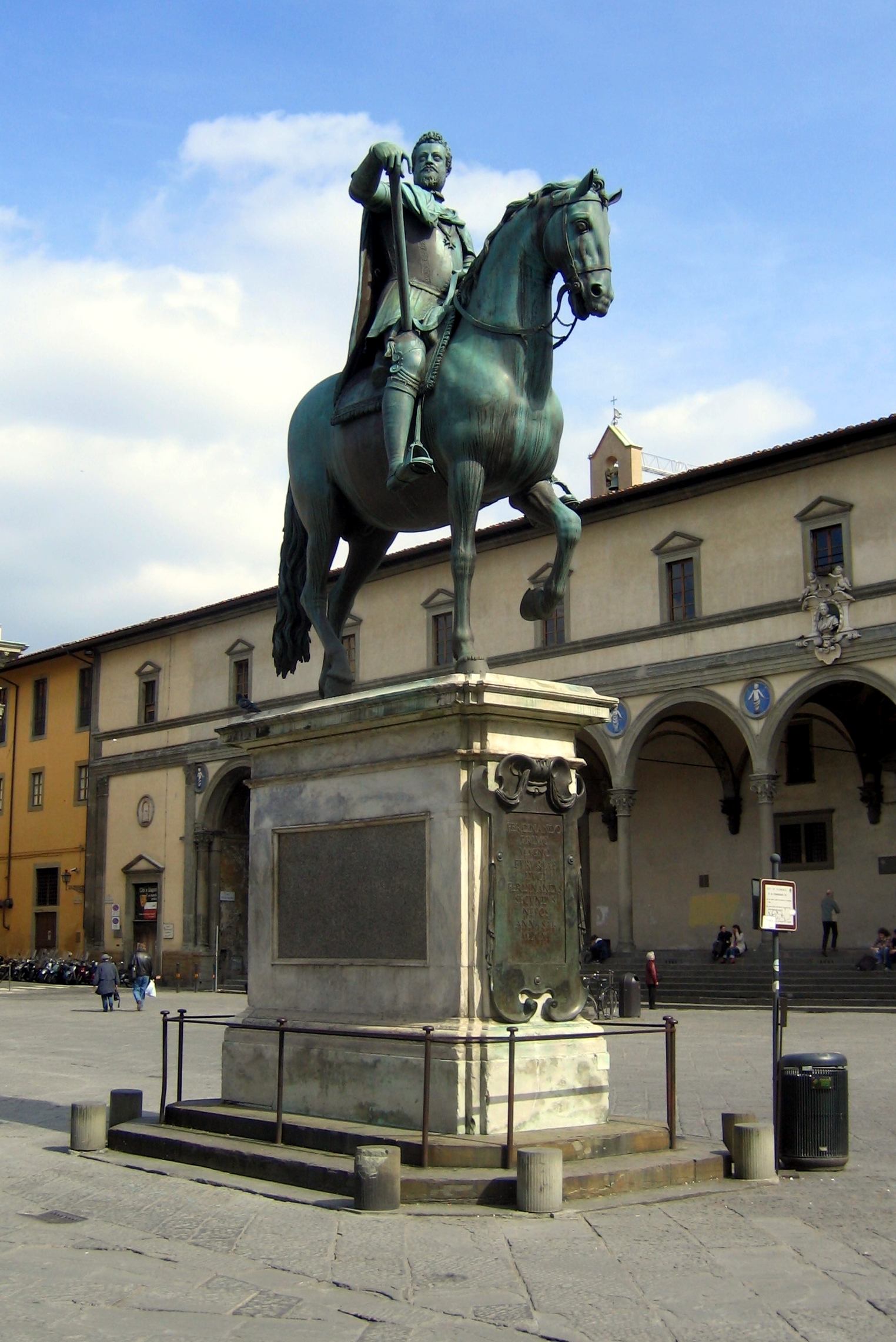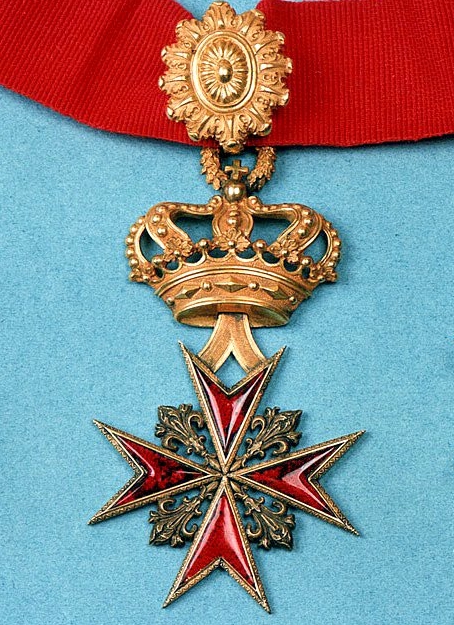|
Equestrian Statue Of Ferdinando I
The Equestrian Monument of Ferdinando I is a bronze equestrian statue by Giambologna, executed in 1602–1607, and erected in 1608 in the Piazza of the Annunziata in Florence, region of Tuscany, Italy. History The monument was commissioned by Cosimo II, son of Ferdinando I de' Medici, Grand Duke of Tuscany, from an elder Giambologna, and was meant to be modeled on the similar Equestrian statue of Cosimo I that stands in the Piazza della Signoria. This project was mainly completed by his pupil Pietro Tacca, and the statue was cast in 1602 and inaugurated at the site in 1608 during the festivities celebrating the marriage of Prince Cosimo II with Maria Maddalena d'Austria. Grandduke Ferdinand wears armour emblazoned on the chest with the Cross of Santo Stefano, an equestrian Order established by Cosimo the elder. It is said the statue was cast with cannons taken from the Turks by the Knights of Santo Stefano. [...More Info...] [...Related Items...] OR: [Wikipedia] [Google] [Baidu] |
Order Of Saint Stephen
The Order of Saint Stephen (Official: Sacro Militare Ordine di Santo Stefano Papa e Martire, "Holy Military Order of St. Stephen Pope and Martyr") is a Roman Catholic Tuscan dynastic military order founded in 1561. The order was created by Cosimo I de' Medici, first Grand Duke of Tuscany. The last member of the Medici dynasty to be a leader of the order was Gian Gastone de Medici in 1737. The order was permanently abolished in 1859 by the annexation of Tuscany to the Kingdom of Sardinia. The former Kingdom of Italy and the current Italian Republic also did not recognize the order as a legal entity but tolerates it as a private body. History The order was founded by Cosimo I de' Medici, first Grand Duke of Tuscany, with the approbation of Pope Pius IV on 1 October 1561. The rule chosen was that of the Benedictine Order. The first grand master was Cosimo himself and he was followed in that role by his successors as grand duke. The dedication to the martyred Pope Stephen ... [...More Info...] [...Related Items...] OR: [Wikipedia] [Google] [Baidu] |
1600s Sculptures
Sixteen or 16 may refer to: *16 (number), the natural number following 15 and preceding 17 *one of the years 16 BC, AD 16, 1916, 2016 Films * ''Pathinaaru'' or ''Sixteen'', a 2010 Tamil film * Sixteen (1943 film), ''Sixteen'' (1943 film), a 1943 Argentine film directed by Carlos Hugo Christensen * Sixteen (2013 Indian film), ''Sixteen'' (2013 Indian film), a 2013 Hindi film * Sixteen (2013 British film), ''Sixteen'' (2013 British film), a 2013 British film by director Rob Brown Music *The Sixteen, an English choir *16 (band), a sludge metal band *Sixteen (Polish band), a Polish band Albums *16 (Robin album), ''16'' (Robin album), a 2014 album by Robin * 16 (Madhouse album), a 1987 album by Madhouse *Sixteen (album), ''Sixteen'' (album), a 1983 album by Stacy Lattisaw *''Sixteen'' , a 2005 album by Shook Ones (band), Shook Ones * ''16'', a 2020 album by Wejdene Songs *16 (Sneaky Sound System song), "16" (Sneaky Sound System song), 2009 *Sixteen (Thomas Rhett song), "Sixteen" ( ... [...More Info...] [...Related Items...] OR: [Wikipedia] [Google] [Baidu] |
Sculptures By Giambologna
Sculpture is the branch of the visual arts that operates in three dimensions. Sculpture is the three-dimensional art work which is physically presented in the dimensions of height, width and depth. It is one of the plastic arts. Durable sculptural processes originally used carving (the removal of material) and modelling (the addition of material, as clay), in stone, metal, ceramics, wood and other materials but, since Modernism, there has been an almost complete freedom of materials and process. A wide variety of materials may be worked by removal such as carving, assembled by welding or modelling, or moulded or cast. Sculpture in stone survives far better than works of art in perishable materials, and often represents the majority of the surviving works (other than pottery) from ancient cultures, though conversely traditions of sculpture in wood may have vanished almost entirely. However, most ancient sculpture was brightly painted, and this has been lost. [...More Info...] [...Related Items...] OR: [Wikipedia] [Google] [Baidu] |
Outdoor Sculptures In Florence ''
{{disambiguation ...
Outdoor(s) may refer to: *Wilderness *Natural environment *Outdoor cooking *Outdoor education *Outdoor equipment *Outdoor fitness *Outdoor literature *Outdoor recreation *Outdoor Channel, an American pay television channel focused on the outdoors See also * * * ''Out of Doors'' (Bartók) *Field (other) *Outside (other) *''The Great Outdoors (other) The Great Outdoors may refer to: * The outdoors as a place of outdoor recreation * ''The Great Outdoors'' (film), a 1988 American comedy film * ''The Great Outdoors'' (Australian TV series), an Australian travel magazine show * ''The Great Outd ... [...More Info...] [...Related Items...] OR: [Wikipedia] [Google] [Baidu] |
Bronze Sculptures In Florence
Bronze is an alloy consisting primarily of copper, commonly with about 12–12.5% tin and often with the addition of other metals (including aluminium, manganese, nickel, or zinc) and sometimes non-metals, such as phosphorus, or metalloids such as arsenic or silicon. These additions produce a range of alloys that may be harder than copper alone, or have other useful properties, such as strength, ductility, or machinability. The archaeological period in which bronze was the hardest metal in widespread use is known as the Bronze Age. The beginning of the Bronze Age in western Eurasia and India is conventionally dated to the mid-4th millennium BCE (~3500 BCE), and to the early 2nd millennium BCE in China; elsewhere it gradually spread across regions. The Bronze Age was followed by the Iron Age starting from about 1300 BCE and reaching most of Eurasia by about 500 BCE, although bronze continued to be much more widely used than it is in modern times. Because historical artworks were ... [...More Info...] [...Related Items...] OR: [Wikipedia] [Google] [Baidu] |
Monuments And Memorials In Florence
A monument is a type of structure that was explicitly created to commemorate a person or event, or which has become relevant to a social group as a part of their remembrance of historic times or cultural heritage, due to its artistic, historical, political, technical or architectural importance. Some of the first monuments were dolmens or menhirs, megalithic constructions built for religious or funerary purposes. Examples of monuments include statues, (war) memorials, historical buildings, archaeological sites, and cultural assets. If there is a public interest in its preservation, a monument can for example be listed as a UNESCO World Heritage Site. Etymology It is believed that the origin of the word "monument" comes from the Greek ''mnemosynon'' and the Latin ''moneo'', ''monere'', which means 'to remind', 'to advise' or 'to warn', however, it is also believed that the word monument originates from an Albanian word 'mani men' which in Albanian language means 'remember ... [...More Info...] [...Related Items...] OR: [Wikipedia] [Google] [Baidu] |
Equestrian Statues In Italy , the fictional nation in which the television s ...
The word equestrian is a reference to equestrianism, or horseback riding, derived from Latin ' and ', "horse". Horseback riding (or Riding in British English) Examples of this are: *Equestrian sports *Equestrian order, one of the upper classes in ancient Rome *Equestrian statue, a statue of a leader on horseback *Equestrian nomads, one of various nomadic or semi-nomadic ethnic groups whose culture places special emphasis on horse breeding and riding *Equestrian at the Summer Olympics, a division of Olympic Games competition Other *The ship ''Equestrian'', used to transport convicts from England to Australia, for example Alfred Dancey. See also *Equestria, Pretoria *Equestria Equestria () is the fictional setting of the fourth and fifth generations of the My Little Pony toy line and media franchise, including the animated television series '' My Little Pony: Friendship Is Magic'' and '' My Little Pony: Pony Life''. ... [...More Info...] [...Related Items...] OR: [Wikipedia] [Google] [Baidu] |
Livorno
Livorno () is a port city on the Ligurian Sea on the western coast of Tuscany, Italy. It is the capital of the Province of Livorno, having a population of 158,493 residents in December 2017. It is traditionally known in English as Leghorn (pronounced , "Leghorn" in the . or ). During the , Livorno was designed as an "". Developing c ... [...More Info...] [...Related Items...] OR: [Wikipedia] [Google] [Baidu] |
Fontana Dei Mostri Marini
The two fontane dei mostri marini ("sea monster fountains") are located in the Santissima Annunziata plaza in the Italian city of Florence. History The two fountains were placed in 1641 at the sides of the Santissima Annunziata plaza, having been commissioned in 1626. The statues were originally intended to complement the Monument of the Four Moors in Livorno. To this end, artist Pietro Tacca began to work on them in 1627 with the help of two students: Bartolomeo Salvini and Francesco Maria Bandini. In 1641, following the death of Tacca, the fountains were placed in the Santissima Annunziata plaza on opposite sides of the Equestrian Monument of Ferdinando I. The fountains were restored over a period spanning from 1987 to 1988, and again between May and June 1996 by Giovanni Morigi under the direction of the Carlo Francini Office of Fine Arts of the City of Florence. Despite these efforts, the statues again began to show signs of material degradation and the fountains were ev ... [...More Info...] [...Related Items...] OR: [Wikipedia] [Google] [Baidu] |
Mannerism
Mannerism, which may also be known as Late Renaissance, is a style in European art that emerged in the later years of the Italian High Renaissance around 1520, spreading by about 1530 and lasting until about the end of the 16th century in Italy, when the Baroque style largely replaced it. Northern Mannerism continued into the early 17th century. Mannerism encompasses a variety of approaches influenced by, and reacting to, the harmonious ideals associated with artists such as Leonardo da Vinci, Raphael, Vasari, and early Michelangelo. Where High Renaissance art emphasizes proportion, balance, and ideal beauty, Mannerism exaggerates such qualities, often resulting in compositions that are asymmetrical or unnaturally elegant.Gombrich 1995, . Notable for its artificial (as opposed to naturalistic) qualities, this artistic style privileges compositional tension and instability rather than the balance and clarity of earlier Renaissance painting. Mannerism in literature and music is not ... [...More Info...] [...Related Items...] OR: [Wikipedia] [Google] [Baidu] |
Ferdinando Tacca, Fontana Dei Mostri Marini, Sx, 01
Ferdinando may refer to: Politics * Ferdinando I de' Medici, Grand Duke of Tuscany (1549–1609) * Ferdinando II de' Medici, Grand Duke of Tuscany (1610–1670) * Ferdinando de' Medici, Grand Prince of Tuscany (1663–1713), eldest son of Cosimo III de' Medici * Ferdinando Gonzaga, Duke of Mantua (1587–1626) * Ferdinando Carlo Gonzaga, Duke of Mantua and Montferrat (1652–1708), only child of Duke Charles II of Mantua * Ferdinando Fairfax, 2nd Lord Fairfax of Cameron (1584–1648), English politician and parliamentary general Sports * Ferdinando De Giorgi (born 1961), Italian volleyball player and coach * Ferdinando Meglio (born 1959), Italian fencer * Ferdinando Piani, Italian bobsledder Other * Ferdinando Galli-Bibiena Ferdinando Galli-Bibiena (18 August 1657 – 3 January 1743),"Galli-Bibiena, Ferdinando" (dates, Farnese dynasty, to Barcelona for Karl VI),''Encyclopedia of Austria'', 2006, aeiou.iicm.tugraz.at webpag."Ferdinando Galli Bibiena Online" (overview ... ( ... [...More Info...] [...Related Items...] OR: [Wikipedia] [Google] [Baidu] |






